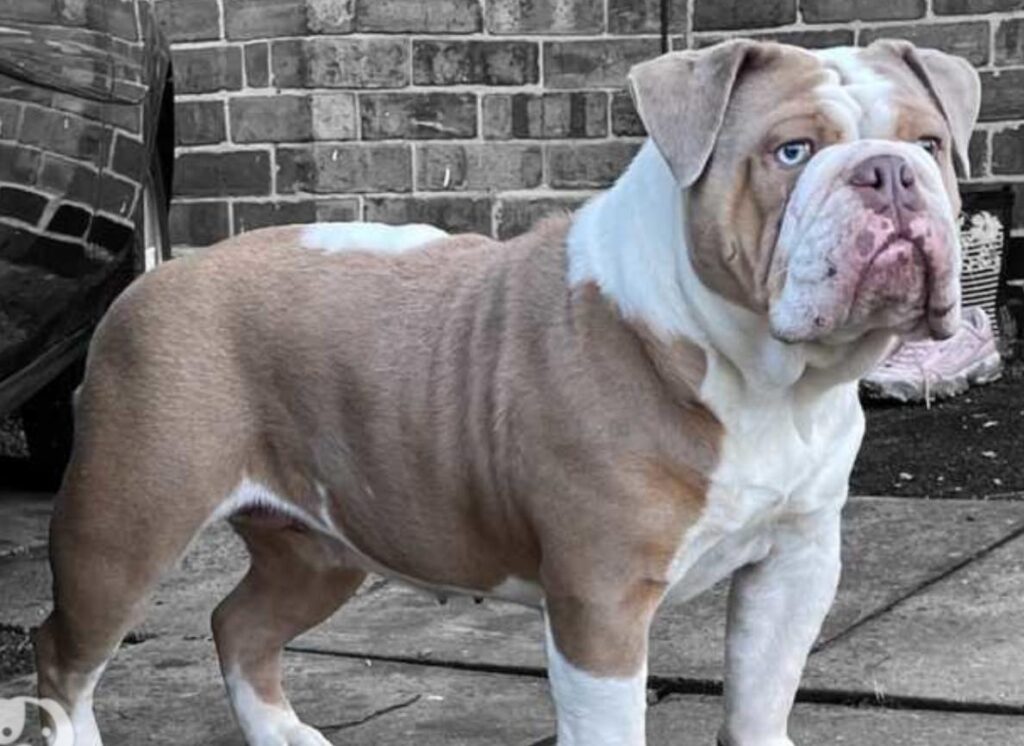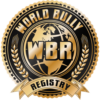
English Bulldog
One of Britain’s oldest indigenous breeds, the Bulldog is known as the National dog of Great Britain and is associated throughout the world with British determination and the legendary John Bull. The Bulldog was first classified as such in the 1630s, though there is earlier mention of similar types referred to as bandogs, a term reserved today for a type of fighting dog. Used originally for bull-baiting, the Bulldog also fought its way through the dog pits, but after 1835 it began to evolve into the shorter-faced, more squat version we know today. It entered the show ring in 1860 and the ensuing years saw a big personality change.
The pugilistic expression of this delightfully ugly dog belies his loving, affectionate nature to family and friends. He has a reputation for tenacity and is very courageous, strong and powerful. Although he is a little bit stubborn by nature, he is good-tempered with children, of whom he is also very protective. The impression he gives of being slow and sluggish is completely contradicted by the great bursts of speed that he can and does produce when the occasion demands. His mood can be dignified, humorous or comical, and he has many endearing ways.
Breed Standard
ORIGIN: Great Britain
BRIEF HISTORICAL SUMMARY: The Bulldog was first classified as such in the 1630s though there is earlier mention of similar types referred to as bandogs, a term reserved today for a type of fighting dog. Used originally for bull-baiting, the Bulldog also fought its way through the dog pits but after 1835 began to evolve into the shorter faced, more squat version we now know. It entered the show ring in 1860 and the ensuing years saw a big personality change. A delightfully ugly dog with a pugilistic expression, which belies a loving, affectionate nature to family and friends. One of the oldest indigenous breeds, known as the national dog of Great Britain, and associated throughout the world with British determination and the legendary John Bull.
GENERAL APPEARANCE: Smooth-coated, fairly thick set, rather low in stature, broad, powerful and compact. Head fairly large in proportion to size, but no point so much in excess of others as to destroy the general symmetry, or make the dog appear deformed, or interfere with its powers of motion. Face relatively short, muzzle broad, blunt and inclined slightly upwards, although not excessively so.
Dogs showing respiratory distress highly undesirable. Body fairly short, well knit, limbs stout, well muscled and in hard condition with no tendency towards obesity. Hindquarters high and strong. Bitches not so grand or well-developed as dogs.
BEHAVIOUR AND TEMPERAMENT: Conveys impression of determination, strength and activity. Alert, bold, loyal, dependable, courageous, fierce in appearance, but possessed of affectionate nature.
HEAD : Viewed from side, head appears very high and moderately short from back to point of nose. Forehead flat with skin on and about head, slightly loose and finely wrinkled without excess, neither prominent nor overhanging face. Face from front of cheek bone to nose, relatively short, skin may be slightly wrinkled.
Distance from inner corner of eye (or from centre of stop between eyes) to extreme tip of nose should not be less than the distance from tip of the nose to edge of the underlip.
CRANIAL REGION:
Skull: Skull relatively large in circumference. Viewed from front appears high from corner of lower jaw to apex of skull; also broad and square. From stop, a furrow, extending to middle of skull being traceable to apex.
Stop: Defined.
FACIAL REGION:
Viewed from front, the various properties of the face must be equally balanced on either side of an imaginary line down centre.
Nose: Nose and nostrils large, broad and black, under no circumstances liver colour, red or brown. Nostrils large wide and open, with well-defined vertical straight line between.
Muzzle: Muzzle short, broad, turned upwards and deep from corner of eye to corner of mouth. Over nose wrinkle, if present, whole or broken, must never adversely affect or obscure eyes or nose.
Pinched nostrils and heavy over nose wrinkle are unacceptable and should be heavily penalised.
Lips: Flews (chops) thick, broad and deep, covering lower jaws at sides, but joining underlip in front. Teeth not visible.
Jaws / Teeth: Jaws broad, strong and square, lower jaw slightly projecting in front of upper, with moderate turn up. Jaws broad and square with six small front teeth between canines in an even row. Canines wide apart. Teeth large and strong not seen when mouth closed. When viewed from front under jaw directly under upper jaw and parallel.
Cheeks: Cheeks well rounded and extended sideways beyond eyes.
Eyes: Seen from front, situated low down in skull, well away from ears. Eyes and stop in same straight line, at right angles to furrow. Wide apart, but outer corners within the outline of cheeks. Round, of moderate size, neither sunken nor prominent, in colour very dark- almost black- showing no white when looking directly forward. Free from obvious eye problems.
Ears: Set high – i.e. front edge of each ear (as viewed from front) joins outline of skull at top corner of such outline, so as to place them as wide apart, as high and as far from eyes as possible. Small and thin. “Rose ear” correct, i.e. folding inwards back, upper or front inner edge curving outwards and backwards, showing part of inside of burr.
NECK: Moderate in length, thick, deep and strong. Well-arched at back, with some loose,
thick and wrinkled skin about throat, forming slight dewlap on each side.
BODY:
Topline: Slight fall to back close behind shoulders (lowest part) whence spine should rise to loins (top higher than top of shoulder), curving again more suddenly to tail, forming slight arch – a distinctive characteristic of breed.
Back: Short, strong, broad at shoulders.
Chest: Wide, prominent and deep. Body well-ribbed up behind. Brisket, round and deep. Well let down between forelegs. Ribs not flat-sided, but well-rounded.
Undeline and belly: Belly tucked up and not pendulous.
TAIL: Set on low, jutting out rather straight and then turning downwards. Round, smooth and devoid of fringe or coarse hair. Moderate in length – rather short than long – thick at root, tapering quickly to a fine point. Downward carriage (not having a decided upward curve at end) and never carried above back. Lack of tail, inverted or extremely tight tails are undesirable.
LIMBS
FOREQUARTERS:
General appearance: Forelegs short in proportion to hindlegs, but not so short as to make back appear long, or detract from dog’s activity.
Shoulder: Broad, sloping and deep, very powerful and muscular giving appearance of being “tacked on” body.
Elbow: Elbows low and standing well away from ribs.
Forearm: Forelegs very stout and strong, well-developed, set wide apart, thick, muscular and straight, bones of legs large and straight, not bandy nor curved.
Metacarpus (Pastern): Short, straight and strong.
Forefeet: Straight and turning very slightly outward; of medium size and moderately round. Toes compact and thick, well split up, making knuckles prominent and high.
HINDQUARTERS:
General appearance: Legs large and muscular, slightly longer in proportion than forelegs. Legs long and muscular from loins to hock.
Stifle (Knee): Stifles turned very slightly outwards away from body.
Metatarsus (Rear pastern): Hocks slightly bent, well let down.
Hind feet: Round and compact. Toes compact and thick, well split up, making knuckles prominent and high.
GAIT / MOVEMENT: Appearing to walk with short, quick steps on tips of toes, hind feet not lifted high, appearing to skim ground, running with one or other shoulder rather advanced. Soundness of movement of the utmost importance.
COAT:
Hair: Fine texture, short, close and smooth (hard only from shortness and closeness, not wiry).
Colour: Whole or smut, (i.e. whole colour with black mask or muzzle). Only whole colours (which should be brilliant and pure of their sort). viz., brindles, reds with their various shades, fawns, fallows etc., white and pied (i.e. combination of white with any of the foregoing colours). Dudley, black and black with tan highly undesirable.
WEIGHT:
Males: 25 kgs.
Females: 23 kgs.
FAULTS: Any departure from the foregoing points should be considered a fault and the seriousness with which the fault should be regarded should be in exact proportion to its degree and its effect upon the health and welfare of the dog.
DISQUALIFYING FAULTS
- Aggressive or overly shy.
- Any dog clearly showing physical or behavioural abnormalities shall be disqualified.
N.B.: Male animals should have two apparently normal testicles fully descended into the scrotum.
The pugilistic expression of this delightfully ugly dog belies his loving, affectionate nature to family and friends. He has a reputation for tenacity and is very courageous, strong and powerful. Although he is a little bit stubborn by nature, he is good-tempered with children, of whom he is also very protective. The impression he gives of being slow and sluggish is completely contradicted by the great bursts of speed that he can and does produce when the occasion demands. His mood can be dignified, humorous or comical, and he has many endearing ways.
